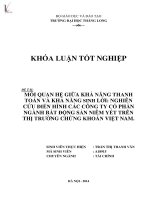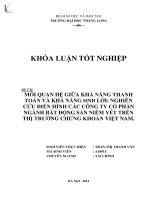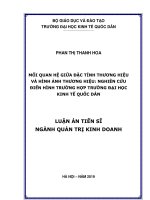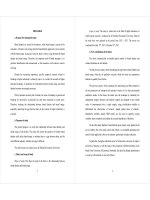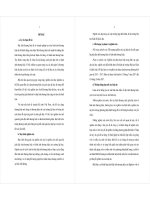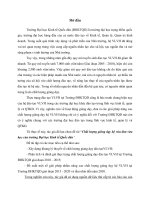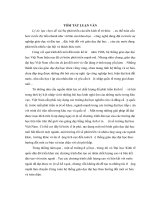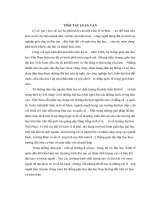Mối quan hệ giữa đặc tính thương hiệu và hình ảnh thương hiệu nghiên cứu điển hình trường hợp trường đại học kinh tế quốc dân tt tiếng anh
Bạn đang xem bản rút gọn của tài liệu. Xem và tải ngay bản đầy đủ của tài liệu tại đây (376.13 KB, 11 trang )
PREAMBLE
Scope of study: The study is carried out in the field of higher education, of
which typical research is conducted at the National Economics University. Data for
a. Reasons for choosing the topic
the study base were gathered in the period from 2013 – 2017. The survey was
Brand identity are created by businesses, while brand image is perceived by
conducted from July 15th, 2017 to October 10th, 2017.
customers. A brand is only strong when the brand identity approach or even coincide
with the brand image. In practice, however, there is always a gap between the brand
identity and brand image. Therefore, the important task of brand managers is to
prioritize identification and measurement, so that measures can be taken to narrow
such gap.
d. New contributions of the thesis
The thesis systematically re-rebuilds typical models of brand identity and
outlines limitations of such models.
Several previous studies, when determining the gap between brand identity and
Despite the increasing importance, specific empirical research related to
branding in higher education is relatively scarce. As a result, the research of higher
education branding, in particular the relationship between brand image and brand
identity becomes increasingly necessary.
brand image, often rely on qualitative research, while this study uses quantitative
methods to quantify those factors.
The previous studies, when examining this relationship, paid little attention to
the two perspectives of enterprise and customer to study; or if so, they are primarily
With a transition economy like Vietnam, the issue of branding in general and
qualitative studies. In this thesis, the author uses the technique of combining two
branding for universities in particular has only been mentioned in recent years.
independent samples (lecturers' and students' samples are designed to have similar
Therefore, studying the relationship between brand identity and brand image,
scales of measurement) into a single sample, using classification variables to
especially measuring the gap between them in the context of higher education, is
differentiate the observations of lecturers’ sample against those of students’.
essential.
Quantitative methods, namely SEM model, are also used to quantify concept
variables (latent variables) and examine the research hypotheses of the thesis.
b. Purposes of study
The general purpose is to study the relationship between brand identity and
brand image of universities. The study will answer the question of whether brand
identity really affect brand image, or whether there is a gap between them, and for
each different audience, whether such gap is different.
The study focuses on a typical case, the National Economics University.
On the other hand, Kapferer's brand identity prism model, rarely applied in the
service industry but in this study, shows that if there is a reasonable adjustment, this
model is fully applicable in the service industry, particularly in higher education.
In particular, the higher education sector in Vietnam has a diversity of subjects
and forms of training, so with the study of the perception of different learners on the
brand of the University of Economics Nationally, the thesis has helped administrators
c. Object and scope of study
to come up with solutions to suit each of them.
Object of study: The object of study of the thesis is the relationship between
brand identity and brand image.
1
2
Brand identity may be influenced by different notions (Balmer and Thompson,
e. Structure of the thesis
The thesis consists of four chapters which are structured as follows:
Chapter 1: Theoretical basis of and research overview
2009). The importance of brand identity is also mentioned by many researchers.
However, the environment is increasingly dynamic and the market often
happens with sudden changes and unpredictable developments. Such challenges open
Chapter 2: Research methods
a new perspective on concepts related to brand identity. Popularly, there are two
Chapter 3: Research results
perspectives on brand identity coexisting: (1) static, fixed, and unchanged over time,
independent of the environmental context, and (2) dynamic, where the core value
Chapter 4: Conclusion and implication of administration
maintains consistent over time, but a part may be adjusted to suit the changing
environment.
CHAPTER 1
THEORETICAL BASIS AND RESEARCH OVERVIEW
1.1. Theoretical basis
This study of the author also agrees that "brand identity" need to be dynamic.
Thus, in addition to the core identity, enterprises may add new identity to match the
fluctuations in market demand. Such view will help the brand grow in a volatile
market and environment, while retaining its core identity to maintain brand stability.
1.1.1. Brand
In 1986, Kapferer first mentioned the concept of "brand identity" and since
In recent years, the term "brand" has become popular. In Vietnam, although
mentioned a lot, many people still do not have a correct and comprehensive view of
this issue. Most of these concepts still come from the perspective of product brands.
When researching service brands, due to the intangible nature of the services, the
category of organizational brand is very important. The organizational brand will
help enterprises provide a clear image, and personalize the values of such
organizations (De Chernatony&McDonald, 2005).
In this study, the brand term is associated with the category of organizational
brand.
then there have been many discussions about its definition and models (Janonis et al.,
2007). The thesis systematizes a number of typical models of brand identity and
points out the basic limitations of these models as follows:
Limitation 1: Most models have not been tested empirically, leading to
difficulties in checking the actual meaning of the factors that constitute these models.
Limitation 2: There is very little research focused on measuring brand identity
Limitation 3: Current models of brand identity mostly come from a commodity
point of view, leaving room for application in service context.
Limitation 4: Researching brand identity depends very much on the views of
1.1.2. Brand identity
managers, while there are few studies standing on the perspective of consumers.
Brand identity originating from the company itself are important factors to
distinguish such company from its competitors. Several researchers identify brand
identity as an emotional structure and originating from brand managers.
3
1.1.3. Brand image
If brand identity are considered as a message originating from the enterprise,
4
brand image is considered as a reflection of consumer awareness. The concept of
brand image has evolved over time. Brand image can be defined as links that brands
suggest in the minds of consumers (Keller, 1993). Therefore, customer behavior will
be affected and determined by brand image (Burmann et al., 2008).
Some studies have shown that brand image can be considered from two
perspectives. The first is that brand image associated with the image of a company or
store is related to the quality and attributes of the organization. The second identifies
that brand image can also be defined as related to people in the organization.
In this study, the author also analyzes brand image from the perspective as
"Brand image is the subjective feeling of customers on the brand" (De Chernatony
and McDonald, 2003); Keller, 2008 and Reizebos, 2003).
1.2. Overview and gap in research on the relationship between brand
identity and brand image
Building and maintaining a strong brand is a challenge in all areas, and higher
education is no exception.
For a training institution like a university, the brand is conceived as a brand of
an organization. Customers of higher education include many subjects, however, due
to limited resources, this study focuses only on students and alumni of different
training systems.
Currently, very few studies focus on studying the relationship between brand
identity and brand image in universities. In particular, the criteria for determining
brand identity and brand image of universities have not been mentioned and tested in
many ways in Vietnam.
1.2.3. Identity of higher education services in Vietnam
So far, we almost still have not conceived that higher education is a kind of
goods and services, so most of the higher education institutions are not interested in
1.2.1. Overview of research on the relationship between brand identity and
brand image
building and developing their brands.
A higher education platform is no longer solely for a "quintessential" part but
The study has made several judgments on the relationship between brand
identity and brand image by some authors, such as Davies (2002), Nandan, (2005),
Vytautas et al. (2007); and re-enumerate the perspectives that previous studies have
has become a mass one. With such a change, learners have more ways to get a college
degree, such as regular training, in-service training, and even distance learning.
1.2.4. Introducing the research context
addressed the relationship between brand identity and brand image.
The thesis also mentions the study by Roy and Banerjee (2014). The authors
Introduction to National Economics University
analyzed Kapferer's brand identity lens (2008) and proposed a method to narrow
On January 25th, 1956, the Prime Minister issued Decree No.678/TTg on
down the gap between brand identity and brand image. To create the minimum gap
theestablishment of the Central Financial and Economic School (now the National
between brand identity and brand image, integration must be done in Kapferer lens,
Economics University). Over 60 years of existence and development, the University
between six aspects, from sender and receiver.
has gained many proud achievements.
1.2.2. Research on the relationship between brand identity and brand image
As of September 2017, the National Economics University has 811 organic
lecturers, including 16 professors, 130 associate professors, 198 doctors, 445 masters,
in universities
and 22 lecturers with university degrees. The University currently has 89 visiting
5
6
Based on the theoretical framework and conceptual model derived from
lecturers.
It can be affirmed that the University is one of the leading units on the
implementation of measures to improve the quality of training and organization of
Kapferer's brand identity lens, along with the proposal of B.Hosseini et al., the author
introduces the conceptual model of this study.
In this model, on the left, the brand identity are sent by the organization and
testing and evaluation of training quality.
Reasons for choosing National Economics University as a subject of
study
consist of six dimensions: physique, personality, culture, relationship, reflection, and
self-image. On the right is brand image which is perceived by and imprinted in the
minds of customers. Any difference between brand identity and image will be
Many public universities in Vietnam still have the concept of "natural scent of
incense", without much attention to brand issues. Therefore, the selection of the
considered as the information gap (the gap between brand identity and brand image),
and that is the same concept that forms the theoretical basis for the study.
National Economics University, a public university, with more than 60 years
existence as typical a subject of study is perfectly reasonable in this situation.
When the Government introduced regulations on autonomy of public service
ORGANIZATION
CUSTOMER
Physique
Physique
Relationship
Relationship
units, many universities were no longer supported with tuition fees. The loss of
tuition advantages has forced them to pay more attention to the branding work. The
National Economics University is one of the first public universities to implement
such autonomy regime.
BRRAND IDENTITY
Reflection
Gap
BRAND IMAGE
Reflection
Scale: The National Economics University is fully qualified for research.
Along with that, the University has a full range of training forms from graduate to
post-graduate, so it will be suitable in helping to assess the diverse views of different
Selfimage
Selfimage
subjects on brand issues.
Character
Character
1.2.3.3. Proposal of research model
Culture
Culture
To be able to provide a suitable research model to measure the gap between
brand identity and brand image, the author derives the thesis from the model of
defining brand identity.
Figure 1.12: Model of researching the gap between brand identity
and brand image
To discuss a possible gap in the thesis and how to shorten such gap, thereby,
strengthening the relationship between brand identity and brand image, Kapferer's
Source: Author's synthesis
Based on the model, the following hypotheses are given:
theory on band lens (2008) will be applied.
7
H1: There exists a significant gap between brand identity and brand image of
8
number. The sample size for alumni and students is 900, of which 799 notes of
the National Economics University.
H2: The feeling of staff and lecturers of the National Economics University
culture will affect their perception of other factors that make up the brand identity of
the University.
questionnaires have been collected, accounting for 88.8%.
2.2. Methods of data collection and analysis
2.2.1. Methods of data collection
H3: The perception of students and learners of the National Economics
University will affect their perception of other factors that make up the brand image
- Secondary information is collected from theses, articles, books, textbooks,
etc. related to brand identity and brand image.
of the University.
- Primary information is collected via in-depth interviews or surveys through
Conclusion of Chapter 1
Chapter 1 presents a theoretical overview of the relationship between brand
identity and brand image, development process, and the results of researchers'
contributions to this relationship. On that basis, a gap in researching the relationship
questionnaires for multi-dimensional information and different perspectives and
views of each individual on brand identity and brand image of the National
Economics University.
2.2.2. Methods of data analysis
in the field of higher education has been discovered and research hypotheses as well
as theoretical models have been formed to measure the gap between brand identity
After using the descriptive statistical method to get an initial look at the variables,
the thesis uses EFA verification to remove variables that are not sufficiently
and brand image.
discriminatory and then applies Cronbach Alpha to verify conformity for scales.
CHAPTER 2
The thesis also explains how to combine two independent samples into a single
RESEARCH METHODS
2.1. Process of building and processing questionnaires and scales
This section introduces the process of developing and processing
questionnaires and the scales in use and research sample.
Research sample: For the University's lecturers, the study is directed to an
expanded group of key officials and lecturers (those who have doctoral and higher
degrees and those who hold management position). For alumni, students and learners,
the study is directed to alumni and current students at the University (regular training,
in-service training, or transitional training, etc), post graduate students, and doctorate
researchers. The sample size used for key officials and lecturers is 350, of which 191
notes of questionnaires have been collected, accounting for 54.6% of the expected
9
one to have a data base to analyze observed variables and statistical relationships and
define concept variables, thereby to provide a way to examine whether there is a gap
between brand identity and brand image.
The thesis uses SEM model with AMOS software to identify conceptual
variables of level 1 and level 2 with tests on the suitability of the model and
Bootstrap test for the analysis model. On that basis, it is used to verify differences
between target groups (lecturers and students) as well as using regression models on
SEM to answer the research questions.
Conclusion of Chapter 2
Chapter 2 has presented research methods including steps: Research design;
process of building and processing questionnaires and scales; introduction of research
10
sample; and methods of analysis and research. In particular, as the thesis research two
component were eliminated. In this study, although these factors are
different samples, the author has used the technique of two independent samples
reliable enough, they are not sufficiently differentiated from other
(lecturers and students' samples which are designed with similar scales) into a single
components. Therefore, these factors need to be considered in other
sample, using categorical variables to distinguish which observations belong to the
contexts.
lecturers’ and students’ samples; and using SEM model to quantify concept variables
(latent variables) and test the hypotheses of the thesis.
CHAPTER 3
RESEARCH RESULTS
3.1. Description of research samples
The survey for official research was conducted from July 15th, 2017 to October
10th, 2017.
• Two components P4 and SI6 were not retained. This is also quite
consistent with the analysis described above. These two components
have a low rating in both the target group and high standard deviation.
3.2.2. Results of Cronbach’s alpha reliability analysis
In this study, to ensure good reliability, scales with Cronbach’s Alpha
coefficient of 0.6 or higher were retained for use in subsequent analysis steps.
The results in this step show that the total correlation coefficients of the
• For alumni and student survey samples: With 799 respondents and a range
of score from 1 to 5, the assessment of alumni and students about the factors
that make up the brand image of the University ranged from 3.389 to 4.272.
observed variables in the scales are greater than 0.4, and the scale used for variables
studying factors F - "physiques", R - "relationship", RC - "reflection", SI - "self
image", P - "personality" is reasonable. All observed variables are accepted and will
be used in analysis of the next factor.
• For key staff and lecturer extended survey sample: With 191 respondents,
the assessment scores for components ranged from 3.450262 to 4.455497
3.2.3. Results of analysis and verification of research hypotheses
- The results of analysis of CFA scale for building brand identity and
3.2. Analysis results
brand image show that a number of indicators reflect the relevance of the model,
3.2.1. Analysis of discovery factors
however, GFI index = 0.881 <0.9 should be concluded. CFA results from this model
The results of exploratory factor analysis based on the combined data between
are not really good (See Appendix 1, for more details of the tests)
two groups of key officials and lecturers and students and learners showed that the
Therefore, the thesis uses MI index to improve the suitability of the model.
data used for factor analysis are perfectly appropriate.
Then, SEM model is used to test the research hypotheses
After that, the author used the factor rotation matrix and focused the
observations on the five representative factors. A number of factors that were not
sufficiently discriminatory were also removed.
• In factor F: Components F6, F7, F8, and F9 - the "invisible physique"
11
- SEM model
To test the hypotheses: There exists a difference between brand identity and
brand image. The thesis will use the variable "phanbiet", a variable used to
12
distinguish brand identity and brand image. The value of variable "phanbiet" is
+ There are differences in brand identity and brand image between two
traditional and modern cultural groups.
defined at 1 for "brand image", or 0 for "brand identity."
The cultural identity defined at 1 for "traditional" and 0 for "modern" group.
- To assess the reliability of the estimates in the model, the thesis uses
algorithm bootstrap algorithm with the number of repeated samples N = 1000. Since
then, the study has come to the conclusion as follows:
+ There is a difference (or gap) of statistical significance and reliability
between brand identity and brand image (coefficient -0.416 implies lower brand
image than brand identity)
+ Index of brand identity and brand image in traditional cultural group is
lower than that of modern culture group (coefficient -0.594)
In addition, the thesis also verifies the role of component factors to concept
variables (latent variables) as brand identity and brand image, and has come to the
conclusion as follows:
+ RC factor plays the biggest role in forming the concept of brand identity and
brand image.
+ Physiques (F) contribute to the potential variables of brand identity and
brand image.
Figure 3.3: Standard SEM model results
+ Personality (P) contributes to a positive direction to potential variables of
Source: Author's research
brand identity and brand image.
Figure 3.3 results show that the model is consistent with the data collected.
+ Reflection (RC) contributes to the positive and the largest (because the
Specifically, a number of indicators are as follows: Chi-square = 11056,648 (p =
standardized coefficient is 1.354) to the potential variables of brand identity and
0,000); Chi-square/df = 3.37 <5; GFI, TLI and CFI are 0.923 respectively; 0.959 and
brand image.
0.965. RMSEA = 0.049 <0.05.
+ Self-image (SI) contributes to a positive direction to potential variables of
Combined with the table of non-standardized regression coefficients of the
brand identity and brand image.
theoretical model, the study has come to the conclusion as follows:
+ Relationship (R) contributes to a positive direction to potential variables of
+ There exists a meaningful gap between brand identity and brand image
13
brand identity and brand image.
14
group with high education and social position, so the underestimation of this group of
brand image is a sign that the University should take into consideration.
After that, the thesis continues to use SEM model in multi-group structure
analysis: group of officials and lecturers (lecturer) and student groups (student).
In general, both models for the student group and the official and lecturer
group provide the acceptable values of GFI, TLI, CFI, and RMSEA, so these models
are quite suitable for analysis. To better assess the reliability of the estimated
coefficients, the thesis uses Bootstrap testing method with the number of sampling
times of 1000
Analysis of the lecturer group:
Auditing with Bootstrap, N = 1000, shows that most indicators CR> 1.96, so
the estimates in the model for the lecturer group independently will be unreliable (see
Appendix 7.2 for details). This can also be explained by the limited samples of this
group.
The following model will help to consider the gap between brand identity and
brand image more intuitively.
The results of the test below show that there are statistically significant
Figure 3.8: Gap between brand identity and brand image
differences between the two groups of students and lecturers, in other words, there
are different impacts from variables to variables "brand" between student group and
lecturer group.
Table 3.13: Differences between the two study samples
Parameter
SE SE-SE Mean Bias
A-B
.117 .004
.000
SE-Bias
-.010 .005
Source: Author's research
Analysis for the student group: The RC factor has the strongest contribution
to the "thuonghieu" variable (in this case, brand image), as this variable has the
highest standardized load factor (1.168).
Source: Author's research
The thesis also analyzes the average value according to the training system of
the student group, and draws the results: Between different education groups, the
perception of brand image is different. The distance-learning group has the lowest
sense of brand image, so this is a group to which the University needs to pay special
attention. The postgraduate group has the next low sense, while this is considered a
15
As shown in Figure 3.8, in all the factors, the next range of noteworthy factor
is R - relationship, and this factor also has the lowest score in the group of distancelearning group, and graduate group.
SI factor - self-image is a highly unifying factor between brand identity and
16
brand image.
and (2) theoretical model.
RC factor - reflection, as analyzed above, is the factor that has the greatest
impact on the relationship between brand identity and brand image.
4.1.1. Measurement model
The results of testing the measurement model for the gap between brand
These analysis and syntheses will be an important basis, helping the University
identity and brand image in the context of higher education in Vietnam, particularly
to know what factors need to be considered to build a strong brand of the National
at the National Economics University show that, after adjusting, all scales gain
University.
reliability.
Conclusion of Chapter 3
The meaning of the above results
Chapter 3 has produced the research results to prove the hypotheses given in
In terms of research methods, this study contributes to the specialization of the
Chapter 2. Through determining the role of each factor in the formation of brand
scale of characterization and brand image in higher education in a transitional
identity and brand image, the thesis has shown that: Between brand identity and
economy of Vietnam.
brand image, there exists a significant gap, and cultural variable plays an important
role, affecting this gap. The author also gives a visual model of the gap between
brand identity and brand image to help readers have a clear view of this gap, from
which, determine what factors to be taken into consideration to shorten the gap
between the brand identity and brand image of the National Economics University.
CHAPTER 4
CONCLUSION AND IMPLICATION OF ADMINISTRATION
On the scale of the factors that make up brand identity and brand image, this
study shows that these factors depend greatly on the identity of the sector. Therefore,
when setting the scales of these factors to apply to different sectors, in addition to
referring to the existing scales, the use of qualitative research to build a specialized
scale of the sector is extremely necessary.
4.1.2. Theoretical model
The testing results show the relevance of the theoretical model with the
Chapter 4, to summarize the main results and draw conclusions from the study,
collected data. In addition, this study also shows that learners (training system) is one
the content of Chapter 4 consists of three parts: (1) Summary of key results and
of the factors that greatly affect customers' perception of brands of universities. This
theoretical and methodological contributions and the meaning of research for
is something that brand strategy makers in higher education should pay attention to.
administrators and researchers; (2) Proposal of a number of solutions to shorten the
4.1.2.1. Contributions to the concept of brand identity and brand image
gap between brand identity and brand image of the National Economics University in
particular and higher education in Vietnam in general; and (3) Limitations and
In this study, the author uses the brand identity model of Kapferer, saying that
brand identity are constituted by 6 factors: culture, physiques, self-image, reflection,
directions for further research.
relationship, and personality. The theories of brand identity are the basis for a
4.1. Main results and contributions of the thesis
The research results are presented in two main parts: (1) Measurement model
17
research model on the gap between brand identity and brand image.
In the research results, it shows that RC factor - reflection (expressing social
18
evaluation of students of the University) plays the biggest role in forming the concept
of brand identity and brand image.
This study has its own limitations as follows:
- The thesis only considers the gap between brand identity and brand image
The research results also show that brand identity and brand image in higher
education in a transitional economy like that in Vietnam also include some basic
components as confirmed in the developed economies. However, as shown above, the
basic components of brand identity should be rearranged to match the identity in
based on a model that is considered the most typical.
- The second limitation relates to the scope of the study: The thesis only
considers this issue in the field of higher education and measures specific results at
the National Economics University.
Vietnam. In addition, when considering this issue in other contexts, particularly in the
service sector, more research on the "invisible physique" component is needed.
Regarding the samples of research: Due to the limitation of resources, this
study focuses only on students and alumni of the training system - the main and most
4.1.2.2. Contributions to research methods
This research opens up a suggestion when considering relationships specifically measuring the gap between brand identity and brand image. The previous
studies, when examining this relationship, paid little attention to the two perspectives
of enterprise and customer to study; or if so, they are primarily qualitative studies.
important customers of a higher education institution.
- In addition, the study was conducted in Vietnam, leading to separate cultural
issues. Therefore, researching issue in different service sectors and other cultural
contexts will help clarify the marginal conditions for different theoretical
generalizations.
4.2. Implications of administration for the University administrators
This thesis has affirmed the role of culture variable to brand identity and brand
image, and culture in a modern way will help develop the brand stand out from the
organizations with traditional culture.
Conclusion of Chapter 4
Based on the analysis results in the previous chapters, Chapter 4 summarizes
the contributions of the research on both theoretical and practical aspects and then
propose a number of suggestions for administrators. Although only case studies are
The thesis also specifies the role of other components, including: "Reflection",
conducted at the National Economics University, the conclusions in Chapter 4 are
"Physiques", "Relationship", "Self-image", and "Personality" to the brand of The
quite relevant and partly show the current situation of the brand issue of Vietnamese
National Economics University, and suggest a number of solutions to help shorten the
education. Chapter 4 also outlines limitations and suggests further research
gap between brand identity and brand image of the University.
directions.
The impact of the training system on the perception of brand image is also
mentioned in this thesis, and the author has suggested points to which the University
should pay attention to improve the students' perception about brand image of the
University
4.3. Limitations of the study and further research directions
19
20
CONCLUDE
Building and maintaining a strong brand is a challenge in all areas, and higher
education is no exception. Meanwhile researching the relationship between brand
identity and brand image, which specifically defines the gap between these two
categories, is an essential job for enterprises.
Through Kapferer's "Brand Identity Lens", the results of a case study at the
National Economics University have shown that: "There exists a significant gap
between brand identity and brand image". In addition, the thesis also studies the
impact of the "Culture" factor, as a moderator variable, on the organization's
perception for brand identity, and customer perception for brand image." The thesis
also confirms the impact of the training system on learners' perception of the brand
image of the University.
Brand identity and brand image are two different but related concepts, and both
are essential components of a strong brand. Brand identity determine the true nature
of the brand. However, in order for the brand to fulfill its positioning objectives,
identity must be perceived and understood by consumers and related partners.
Therefore, if the gap between these two factors is large, it is an alarming sign for the
organization. From the results, the study has provided a number of recommendations
for administrators, to help narrow the gap between brand identity and brand image.
It can be affirmed that, at present, building and developing brand is an essential
job for higher education institutions. It is the time higher education institutions must
see educational services as a "special kind of goods and services", which students and
learners are customers of attention. Therefore, higher education institutions need to
select appropriate core identity for their brands and convey those identity to
customers in order to create close relationships, thereby shortening the gap between
brand identity and brand image.
21
